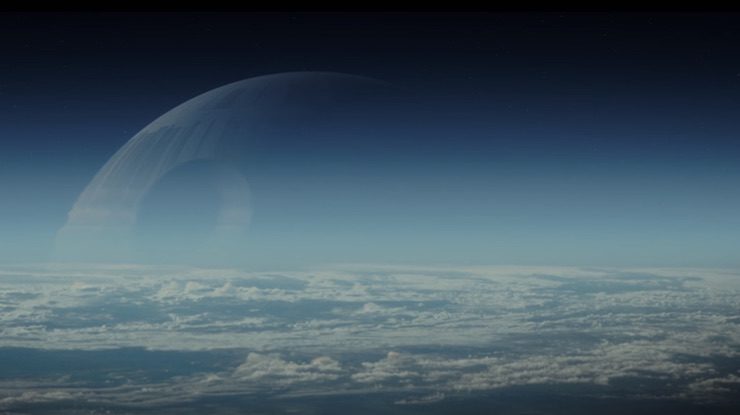It is easy to like Rogue One: A Star Wars Story because it really wants you to like it. There’s a lot of hyperbole surrounding its release already, including a review from Variety hailing it as the first “Star Wars movie for grown-ups,” and fans and critics alike espousing its virtues as a love letter to the fandom.
But for a film that is meant to be so many things to so many people, it is shockingly thin on substance. The truth is, what Rogue One truly succeeds at is repackaging a familiar experience so expertly that it feels unique.
(Spoilers for the film below.)
Wait, I can hear you say. You’re talking about “The Force Awakens”. No, I’m not. Episode VII did have those same hallmarks (story echoes, trope replications, characters we have already seen), but it benefited from its place in the timeline of the universe—being set in the future forced the creatives involved to conceive of the differences that a new trilogy of films would have from its predecessors. To that effect we have new organizations, equipment, and context that demands that the audience engage with a new status quo. The First Order is similar to the Empire, but it isn’t the Empire. The Resistance is close to the Rebel Alliance in its affiliations, but born of a different political era. But Rogue One is situated within a story that you already know. It handles its material with enough panache to make everything seem fresh and new, but this is nothing that fans haven’t already seen before.
This is not to say that Rogue One is a bad movie; there are many aspects of the film that are exceptional and worthy of recounting. Gareth Edwards is a director who clearly speaks the language, and the film is a gorgeous meditation on the imagery of Star Wars, the way that these films have used the visual to tap into its audience’s subconscious for decades. The actors give their all with what they’ve been allotted, and the way that the latter half of the film uses war movie constructs to give audiences a battle on an entirely different scale is totally impressive. It is also effecting because the stakes are known—more than known, they are essential to the story’s mythology. There is no way to avoid having emotions about the content of Rogue One because they are built-in from diving headlong into a key piece of narrative that was seeded in the very beginning of the first film.
But the problem with labeling something “gritty” and “grown-up” is that these are lazy monikers that we often attribute to anything that delivers on tragedy and violence, regardless of the specificity of their use. Having a rough battle sequence and character deaths does not make a movie “grown-up,” and grit has never been a guarantee of quality. It might be refreshing to see in a Star Wars film, but that does not make Rogue One more worthy of praise than any other Star Wars film.
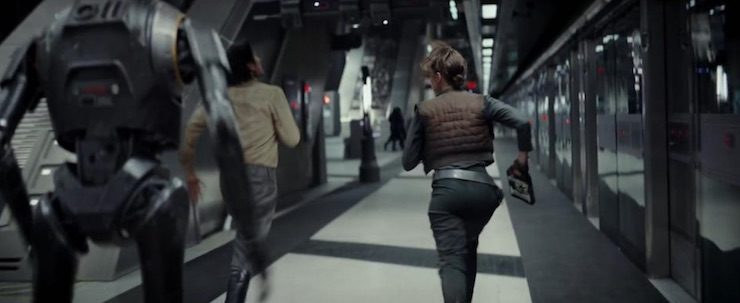
And that is a problem because all the heaping praise avoids the fact that this is a very awkwardly constructed film whose themes are as muddy as its character work. It’s unclear if heavy reshoots are to blame (though a quick look at the trailers confirms that not only were many scenes divulging Jyn’s personality cut from the film, but that the entire third act was reworked completely), or if Rogue One simply forgot what makes war films so affecting—getting close to characters who are likely to die before the end credits.
Rogue One’s ensemble is a deliriously talented crew, but they are given a pitiful amount to work with in terms of history or personality. There are literally two conversations in the entire film meant to build this disparate group into a working unit; one when Cassian Andor (Diego Luna) is talking to Chirrut (Donnnie Yen) and Baze (Jiang Wen) in Saw Gerrera’s prison cell, and another when Jyn Erso (Felicity Jones) tells Cassian off for lying to her about his mission from the Alliance to kill her father. These two moments—along with a single fight sequence on the planet Jedha where Chirrut and Baze prove how adept they are at combat—are really all that the audience gets by way of their forming into a group of comrades who are willing to face insurmountable odds together. It’s not enough for a true ensemble tale, and even more confusing because the movie is never clear on whether it is actually meant to be an ensemble tale… or a tale about Jyn Erso alone.
Jyn from the trailers for Rogue One seems like an utterly different person in the theater. Gone is the snappy misfit who has no interest in authority and mouths off to Mon Mothma. In her place we have a nice woman who is without a family and maybe looking for a new one? Rogue One is completely uninterested in explaining Jyn’s motivations to the audience, or at the very least is intent on confusing us about them. On one hand, Jyn seems to be helping the rebels for her father, a man who was manipulated into working for the Empire and helping them to develop the Death Star weapon. (I could say she was doing it for her family, but her mother might as well not exist for the fact that she is never brought up again after her death.) On the other hand, by the end of the film we have Jyn giving a rousing speech about hope, and the soundtrack seems to indicate that Jyn is truly on board for the cause now. It’s a shame because the film misses out on the more interesting possibility—that Jyn is playing the Rebel Alliance into helping her get vengeance for her family. That kind of morally complex motivation is exactly what the war movie genre is great at showcasing.
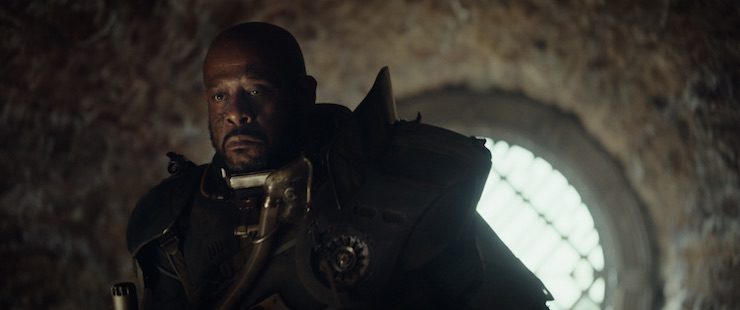
Many of the best characters in the film we lose before properly getting to know them: Saw Gerrera (Forest Whitaker, how do I love thee? How much did I miss you in the rest of this movie?), who kicks it in the opening act after displaying very little extremism for an extremist. K-2SO, who is the most entertaining of the bunch, but gets even less respect in the character integrity and background department—we should hardly be surprising, seeing as he’s a droid and Star Wars famously ignores droids outside of their ability to provide amusement. Bodhi Rook (Riz Ahmed), whose defection from the Empire is barely even considered from a narrative standpoint. Chirrut and Baze, who get perhaps more focus than the other secondary characters, but still both die without getting the emotional through lines we expect from central characters. We know practically nothing of their complete history together, their purpose of guarding the temple on Jedha, how their people were involved with the Jedi Order. We just get a mantra, spoken by Chirrut and finally Baze, to make up the entire emotional crux of their part in the story.
Then we have Cassian, who we know has done bad things on the behalf of the Rebellion because he tells us and shoots his informant at the start of the film. But we never get wind of what exactly he’s been doing for the Alliance, we just know it’s bad and he’s done it and we should feel bad for him because he feels bad. This would have been fine with another film still coming, to better expand on his history. Without that possibility, we lose a character who is playing at a depth of emotion that we have to guess around.
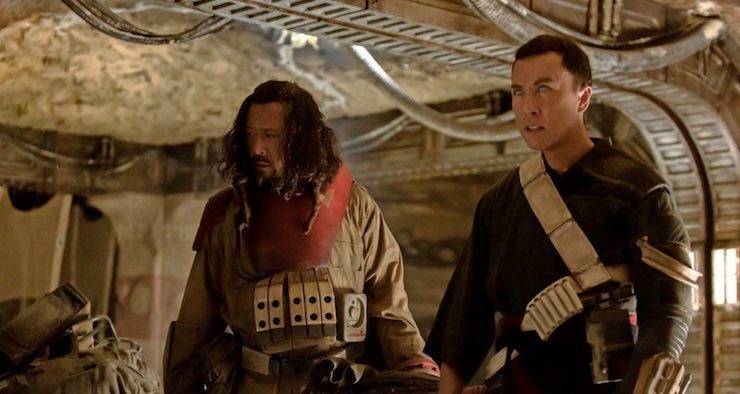
We also have Orson Krennic, the man behind the Death Star project, and while Ben Mendelssohn does an excellent job in his role, nothing can cover up the fact that his entire character could be cut from the film and nothing would be lost. His machinations are irrelevant to the outcome of the story, and all his whining and posturing do not make the incoming reality of the Death Star seem more fraught or threatening. He merely exists to snipe at a characters who we already know and want to see more of.
On that note, a moment for Grand Moff Tarkin, whose CGI use was both jarring and exceedingly creepy. I know that the filmmakers got permission from Peter Cushing’s Estate, but there is something disturbing (and unethical?) to knowing that you can appear briefly in a Star Wars film and it means that you might have you face grafted onto a CGI frame long after your death. Not only does the film not need to show us Tarkin at such length, but no amount of computer advancement can change the fact that a CGI simulacrum cannot act as Cushing could. The whole move is alarmingly disrespectful and makes all of Krennic’s scenes even more discomfiting to squirm through.
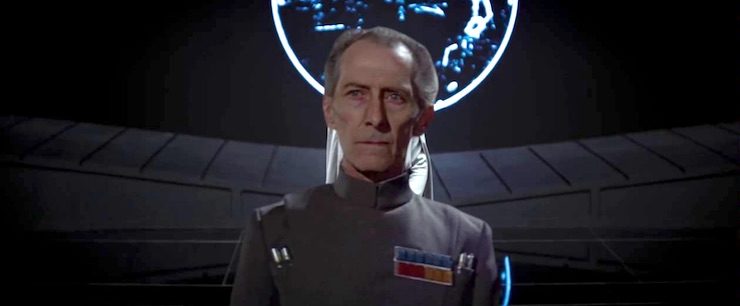
The same goes for Princess Leia, whose face did not need to be seen at the end of the film. One shot of her hand on the plans would have been entirely sufficient.
There is another hole in this film, and it is female-shaped. The fact that Rogue One managed to have fewer speaking parts for women in it than Force Awakens did is appalling. The fact that no one in Jyn’s core team is also female is equally ridiculous. The fact that the entire group Cassian presents to Jyn who have volunteered to go on her impossible mission are all men is insulting in the extreme. Sure, a few female pilots show up once the full Alliance forces enter the fray at the end of the film, but until then it is literally one woman leading up a band of men. What the movie ends up accidentally implying by this omission is that no female operatives have ever done horrific things on behalf of the Rebel Alliance. Only men who Cassian can vouch for. At least with the Empire there has been a xenophobic and sexist precedent built into the organization to account for the lack of women in their ranks. With women like Leia and Mon Mothma at the forefront, the Rebel Alliance has no such excuse.
Even with all these problems (and more), there are plenty of things in Rogue One that are exciting. Jimmy Smits is still a gem as Bail Organa, and the appearance of Darth Vader was a treat in this context. The difficulty of the mission was hammered home with every extra step that the plan garnered. Hearing pointless stormtrooper banter again was oddly endearing. But the theme of Rogue One remains a mystery. Is it about one person changing the course of galactic history? Is it about the need to trust others in order to accomplish your goals? Is it about how the people who win wars are usually the ones who have given up the most to their causes, done the hard work that others were unwilling to do? All of these are possibilities, but Rogue One refuses to single out a message because it’s too focused on ending with the sight of something familiar.
And while seeing Princess Leia get her hands on the Death Star plans is a rewarding thing, it should not be the emotional pinnacle of a film where so many good people have lost their lives.
So Rogue One was a fascinating Star Wars film, but calling it the only one available for “grown-ups” is a trite assessment in my book. A story requires more than constant violence and circumspect morality to get that label. And for the record, Star Wars films have always featured these elements—this is merely the first time our attention has been called to them. For a first attempt at drawing out those ideas, Rogue One does an acceptable cursory job. Let us hope that the next attempt—if there is one—will go further.
Emmet Asher-Perrin still can’t believe that not a single person in Jyn’s group was another woman. You can bug her on Twitter and Tumblr, and read more of her work here and elsewhere.










